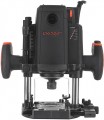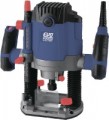Power
The total power of the router, more precisely, the engine installed in it. The
higher this indicator, the more productive the device is, the better it copes with complex work, the more force on the cutter (torque) it provides during operation, and the greater the spindle speed can be (although a powerful tool is not necessarily high-speed). On the other hand, high power significantly affects the dimensions, weight and price of the tool, plus power consumption and network load increase accordingly. In addition, high torque in some cases (for example, with delicate processing) is frankly undesirable. Therefore, a tool should be chosen according to this parameter, taking into account the real needs and the specifics of the planned work.
There are three main categories of milling cutters in terms of power: light (up to 700 W), designed mainly for simple household work; medium (up to 1500 W), able to cope not only with domestic, but also with most professional tasks; and heavy (1500 W or more), used in cases where high power is critical. However, this gradation is true only for routers (see "Type"), other varieties have their own specifics: for example, lamellar models, in principle, do not need high power.
Min. speed
The slowest spindle speed (in revolutions per minute) provided by the router motor.
For different jobs, the optimal spindle speed (and, accordingly, the cutter) will also be different. For example, hard materials like stone require fast rotation, but wood does not; some types of nozzles work better at high speeds, others at low speeds, etc. Detailed recommendations for each specific case can be found in special sources. Here we note that the smallest value of the minimum number of revolutions found in modern milling cutters is about 3000 – 5000, and in the most "fast" models this figure can exceed 15000. When choosing, pay attention not so much to the minimum rotation speed as to the total speed range — how it corresponds to the planned tasks.
Max. speed
The highest spindle speed provided by the router motor. Measured in revolutions per minute. For models that do not have speed control (see "Functions"), this paragraph indicates the standard number of revolutions.
For different work, the optimal speed of rotation of the spindle (and, accordingly, the cutter) will also be different. For example, hard materials like stone require fast rotation, but wood does not; some types of nozzles work better at high speeds, others at low speeds, etc. Detailed recommendations for each specific case can be found in special sources. When choosing, it is worth paying attention not so much to the maximum rotation speed as to the general range of speeds - how much it corresponds to the planned tasks. We only note that in models with a large allowable cutter diameter (see below), the maximum rotation speed can be relatively low - the working edge of a large cutter moves quickly even at low speeds, and for effective acceleration of such a nozzle, too much power would be needed.
Max. cutter diameter
The largest diameter of the cutter that can be installed in the router.
The larger the cutter, the faster its cutting edge moves and the more material it can capture, but larger nozzles require more torque. Accordingly, the maximum diameter of the cutter is directly related to the power of the tool (see above): the larger the allowable size of the nozzle, the more powerful and advanced, usually, the router is. However, large cutters (as, in fact, high power) are not always really needed. Therefore, when choosing according to this parameter, it is worthwhile to adequately evaluate the upcoming work and not chase the maximum size.
Stroke
The distance by which the height of the cutter can change relative to the support platform of the router, in other words, to what depth the working nozzle can be lowered relative to the upper position. This parameter is used for vertical and edge models (see "Type"); however, edge routers with height adjustment are very rare. In fact, the amount of travel not only describes the maximum working depth provided by the tool, but also indicates the presence of depth adjustment; for models without such adjustment, this parameter is not indicated at all.
As for specific numbers, for simple household work, a stroke of 25–30 mm is considered quite sufficient, and in a more serious tool, values of 70–80 mm can be found.
Functions
—
Soft start. The presence of a soft start engine in the design of the milling cutter. A feature of most modern electric motors is that when connected to the network directly, without control circuits, at the time of start-up, there is a sharp jump in current through the motor. This, on the one hand, creates voltage fluctuations in the mains (which can “knock out” fuses or become fatal for some devices operating nearby), on the other hand, it leads to a sharp jerk of the tool, due to which it can be released from hands (and this cause damage to surrounding objects and even injury). This function also limits the current at the moment of starting the motor. Due to this, the speed increases smoothly, without jerking the tool, and the power grid is not subjected to excessive overloads.
—
Adjustment of frequency of rotation. The presence of a speed controller in the design of the milling cutter. This function allows you to change the spindle speed, adjusting it to different types of work — for example, to effectively cut hard material, you may need a high speed, and with soft woods, you can work at low speeds. Tools with speed control will be useful especially for those who have to deal with a wide variety of materials. In this case, the range of such adjustment may be different.
—
Microlift. The presence in the design of the router of a system for fine-tuning
...the depth with an accuracy of 0.1 mm. The standard setting with the limit pin is very coarse, as the errors are quite large. The microlift is used where it is important to set the depth very accurately. It is implemented mainly by means of a threaded connection that limits the vertical downward movement, or is completely integrated into the vertical travel design, where unlocking is not needed to make the necessary adjustments.
— Backlight. The presence of a lighting system in the design of the router — in fact, an ordinary flashlight that facilitates work in dimly lit places. The need for backlighting may arise even in daylight or bright artificial lighting — the place of work is quite often in the shade (for example, from the head of the operator himself).
— Maintain momentum. The presence in the design of the milling cutter of a system that automatically adjusts the engine operation mode depending on the load on the working nozzle — in such a way that the rotational speed remains constant, does not fall under load and does not increase at idle. Thanks to this adjustment, a constant quality of processing is ensured, practically independent of the pressure on the nozzle, wear of the nozzle and the tool itself is reduced, as well as overall energy consumption.Power cord length
The length of the power cord provided in the design of the router.
The long cord, on the one hand, allows the tool to easily “reach” quite remote sockets, provides additional freedom of action and eliminates the need to switch to another socket once again. On the other hand, it can be inconvenient if the power source is not far away and the excess cord has to be stored on the floor, chair, etc.; and with insufficient length, it is quite possible to use an extension cord. Therefore, in most modern routers, the length of the cord is about 2 – 4 m — this is quite enough to reach the outlet in most cases, and at the same time not so much that there is inconvenience due to the large excess.

